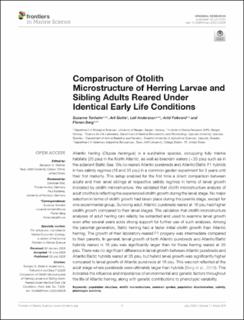| dc.contributor.author | Tonheim, Susanne | |
| dc.contributor.author | Slotte, Aril | |
| dc.contributor.author | Andersson, Leif | |
| dc.contributor.author | Folkvord, Arild | |
| dc.contributor.author | Berg, Florian | |
| dc.date.accessioned | 2021-03-30T11:40:28Z | |
| dc.date.available | 2021-03-30T11:40:28Z | |
| dc.date.created | 2020-08-08T12:39:30Z | |
| dc.date.issued | 2020-07-03 | |
| dc.Published | Frontiers in Marine Science. 2020, 7 (529), . | |
| dc.identifier.issn | 2296-7745 | |
| dc.identifier.uri | https://hdl.handle.net/11250/2736118 | |
| dc.description.abstract | Atlantic herring (Clupea harengus) is a euryhaline species, occupying fully marine habitats (35 psu) in the North Atlantic, as well as brackish waters (<20 psu) such as in the adjacent Baltic Sea. We co-reared Atlantic purebreds and Atlantic/Baltic F1 hybrids in two salinity regimes (16 and 35 psu) in a common garden experiment for 3 years until their first maturity. This setup enabled for the first time a direct comparison between adults and their larval siblings at respective salinity regimes in terms of larval growth indicated by otolith microstructure. We validated that otolith microstructure analysis of adult otoliths is reflecting the experienced otolith growth during the larval stage. No major selection in terms of otolith growth had taken place during the juvenile stage, except for one experimental group. Surviving adult Atlantic purebreds reared at 16 psu had higher otolith growth compared to their larval stages. The validation that otolith microstructure analyses of adult herring can reliably be extracted and used to examine larval growth even after several years adds strong support for further use of such analyses. Among the parental generation, Baltic herring had a faster initial otolith growth than Atlantic herring. The growth of their laboratory-reared F1 progeny was intermediate compared to their parents. In general, larval growth of both Atlantic purebreds and Atlantic/Baltic hybrids reared in 16 psu was significantly larger than for those herring reared at 35 psu. There was no significant difference in larval growth between Atlantic purebreds and Atlantic/Baltic hybrids reared at 35 psu, but hybrid larval growth was significantly higher compared to larval growth of Atlantic purebreds at 16 psu. This was not reflected at the adult stage where purebreds were ultimately larger than hybrids (Berg et al., 2018). This indicates the influence and importance of environmental and genetic factors throughout the life of Atlantic herring, along with genetic contributions to phenotypic variability. | en_US |
| dc.language.iso | eng | en_US |
| dc.publisher | Frontiers Media | en_US |
| dc.rights | Navngivelse 4.0 Internasjonal | * |
| dc.rights.uri | http://creativecommons.org/licenses/by/4.0/deed.no | * |
| dc.title | Comparison of Otolith Microstructure of Herring Larvae and Sibling Adults Reared Under Identical Early Life Conditions | en_US |
| dc.type | Journal article | en_US |
| dc.type | Peer reviewed | en_US |
| dc.description.version | publishedVersion | en_US |
| dc.rights.holder | Copyright 2020 Tonheim, Slotte, Andersson, Folkvord and Berg | en_US |
| dc.source.articlenumber | 529 | en_US |
| cristin.ispublished | true | |
| cristin.fulltext | original | |
| cristin.qualitycode | 1 | |
| dc.identifier.doi | 10.3389/fmars.2020.00529 | |
| dc.identifier.cristin | 1822249 | |
| dc.source.journal | Frontiers in Marine Science | en_US |
| dc.source.40 | 7 | |
| dc.source.14 | 529 | |
| dc.source.pagenumber | 1-13 | en_US |
| dc.relation.project | Norges forskningsråd: 254774 | en_US |
| dc.identifier.citation | Frontiers in Marine Science. 2020, 7, 529, 1-13 | en_US |
| dc.source.volume | 7 | en_US |

